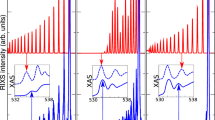Abstract
WE have recently been investigating the far ultra-violet absorption spectra of a number of organic compounds of the type R1COOR2; R being an alkyl group or a hydrogen atom. It has been found that only the simplest of these, namely formic acid, shows discrete absorption bands in the region 2000–1000 A. The interpretation of the electronic structure of the carboxyl group will therefore depend to a considerable extent upon the analysis of these discrete bands.
This is a preview of subscription content, access via your institution
Access options
Subscribe to this journal
Receive 51 print issues and online access
$199.00 per year
only $3.90 per issue
Buy this article
- Purchase on Springer Link
- Instant access to full article PDF
Prices may be subject to local taxes which are calculated during checkout
Similar content being viewed by others
References
Price, W. C., J. Chem. Phys., 3, 256 (1935).
Mulliken, R. S., J. Chem. Phys., 3, 564 (1935).
Hibben, J. H., Chem. Rev., 18, 1 (1936).
Author information
Authors and Affiliations
Rights and permissions
About this article
Cite this article
EVANS, W., PRICE, W. Absorption Spectrum of the Carboxyl Group in the Vacuum Ultra-Violet. Nature 139, 630–631 (1937). https://doi.org/10.1038/139630a0
Issue Date:
DOI: https://doi.org/10.1038/139630a0
This article is cited by
Comments
By submitting a comment you agree to abide by our Terms and Community Guidelines. If you find something abusive or that does not comply with our terms or guidelines please flag it as inappropriate.



